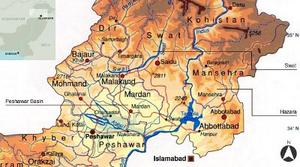Osama bin LadenGeographers predicted bin Laden's hideout location
They do not work for the CIA or military intelligence, but undergraduate students at UCLA two years ago helped develop an analytical tool which allowed them to predict Osama bin Laden’s hiding place — well, almost predicted: their model said that there was a 80.9 percent chance that bin Laden was hiding in the town of Abbottabad, where he was killed on Sunday by U.S. special forces; the students used a theory called “island biogeography”; the theory says that species on large islands are much more likely to survive a catastrophic event than species on small islands; “The theory was basically that if you’re going to try and survive, you’re going to a region with a low extinction rate: a large town,” says the professor who guided the research

Abbottobad in lower right of map, picked by students // Source: officelive.com
They do not work for the CIA or military intelligence, but undergraduate students at UCLA two years ago helped develop an analytical tool which allowed them to predict Osama bin laden’s hiding place. Well, almost predicted: their model said that there was a 80.9 percent chance that bin Laden was hiding in the town of Abbottabad, where he was killed on Sunday by U.S. special forces. Science reports that UCLA geographer Thomas Gillespie, together with colleague John Agnew and a class of undergraduate students, developed a probabilistic model about the whereabouts of bin laden. Gillespie was teaching a class on remote sensing, and he and the students used publically available information on bin Laden’s movements before he disappeared to predict where he was likely to be.
Science notes that the students used a theory called “island biogeography.” The theory says that species on large islands are much more likely to survive a catastrophic event than species on small islands. “The theory was basically that if you’re going to try and survive, you’re going to a region with a low extinction rate: a large town,” Gillespie says. “We hypothesized he wouldn’t be in a small town where people could report on him.”
“It’s not my thing to do this type of [terrorism] stuff,” he says. “But the same theories we use to study endangered birds can be used to do this.”
Based on the information on bin Laden’s movements and on the theory, the group predicted that bin Laden was hiding in the Pakistani city of Parachinar, a town not unlike Abbotabbad (the model predicted that there was a 100 percent likelihood that bin Laden was in Parachinar, and 80.9 percent that he was in Abbottabad). Gillespie said that one of the problems they faced was the fact that there was no reliable information about bin Laden’s movements after 2001.
Still, Gillespie was not surprised that bin Laden was in a town. “Caves are cold, and you can’t see people walking up to them,” he says. The late al Qaeda leader made a bad choice of real estate, in Gillespie’s opinion. “An inconspicuous house would have suited him better.”
— Read more in Thomas W. Gillespie et al., “Finding Osama bin Laden: An Application of Biogeographic Theories and Satellite Imagery,” MIT International Review (17 February 2009)
